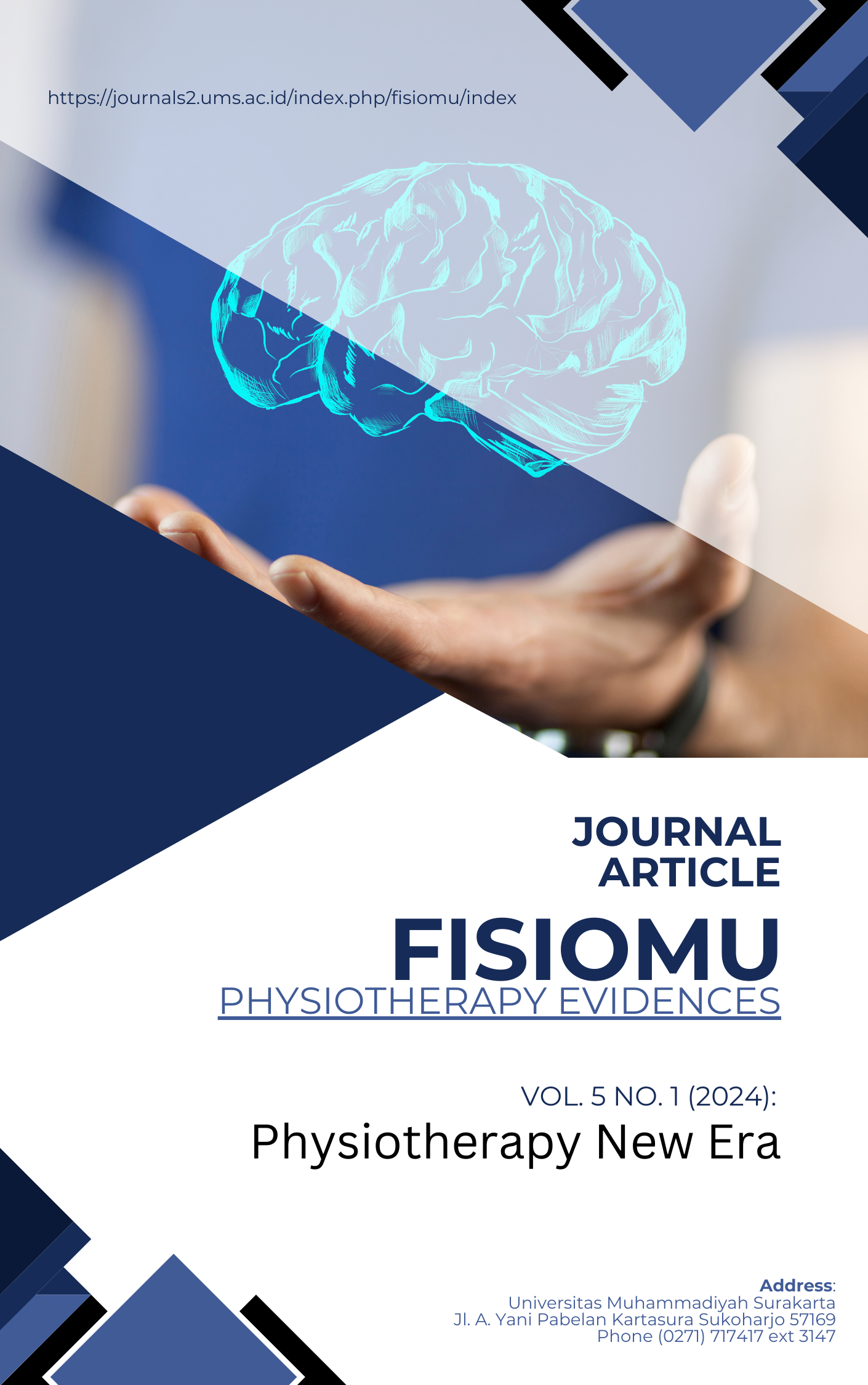The Effectiveness of Tai Chi Exercises on Postural Balance in the Elderly in RS. Hermina Depok
DOI:
https://doi.org/10.23917/fisiomu.v5i1.3179Keywords:
Tai Chi, Postural Balance, Elderly, ExercisAbstract
Introduction: As a person gets older, the functions of his/her body organs decrease. A person will experience many declining abilities, including a decrease in postural balance. Postural balance is the ability to maintain the body in an upright position by aligning the centre of gravity and base of support with appropriate body movements and using minimal muscle activity without excessive muscle contraction. Decreased balance function will increase the risk of falls in the elderly, therefore balance is the most important problem for every elderly. Currently, many methods or types of exercises aim to improve postural balance. One of them is the provision of gymnastics. Tai Chi exercise is an exercise originating from China, which consists of various sequences of movements with the aim of training body coordination and balance. To determine the effectiveness of Tai Chi exercises on postural balance in the elderly. Methods: This study used a quasi-experimental method with the research design used was pretest and posttest two group design. The sample in the study was elderly aged 60 years and over with a total of 32 person, where the sample was divided into 2 groups, namely 16 person in the control group and 16 person in the treatment group. The measuring instrument used was the Functional Reach Test which was carried out before and after being given Tai Chi exercises. The research was conducted at RS Hermina Depok, Physiotherapy Clinic, starting from January to March 2023. Results: This study shows that Tai Chi exercises significantly improve postural balance in the elderly (p=0.001). Conclusion: The provision of Tai Chi exercises is significant in improving postural balance in the elderly.
Downloads
References
Adi, S., Kurniawan, S., & Ardian, K. (2020). Efek Senam Lanjut Usia Terhadap Peningkatan Aktifitas Fisik Lanjut Usia Di Dusun Bonorejo Kelurahan Plesungan. Wiraraja Medika : Jurnal Kesehatan, 10(1), 17–22.
Cuevas-Trisan R. (2019). Balance Problems and Fall Risks in the Elderly. Clin Geriatr Med. May;35(2):173-183.
Fatih Soke, Sefa Eldemir, Taskin Ozkan, Cagla Ozkul, Elvan Ozcan Gulsen, Cagri Gulsen, Kader Eldemir, Ceyla Irkec, Kocer Bilge Gonenli, Hale Zeynep Batur Caglayan & Arzu Guclu-Gunduz (2022) The functional reach test in people with multiple sclerosis: a reliability and validity study, Physiotherapy Theory and Practice, 38:13, 2905-2919
Haruko, Kage & Okuda, Masayuki & Nakamura, Ippei & Kunitsugu, Ichiro & Sugiyama, Shinichi & Hobara, Tatsuya. (2009). Measuring Methods for Functional Reach Test: Comparison of 1-Arm Reach and 2-Arm Reach. Archives of physical medicine and rehabilitation. 90. 2103-7.
Irfan Muhammad. (2010). Fisioterapi Bagi Insan Stroke. Graha Ilmu.
Jenkins ME, Johnson AM, Holmes JD, Stephenson FF, Spaulding SJ. (2010). Predictive validity of the UPDRS postural stability score and the Functional Reach Test, when compared with ecologically valid reaching tasks. Parkinsonism Relat Disord. Jul;16(6):409-11.
Jose Antonio Merchán-Baeza, Manuel González-Sánchez, Antonio Ignacio Cuesta-Vargas, (2014). "Reliability in the Parameterization of the Functional Reach Test in Elderly Stroke Patients: A Pilot Study", BioMed Research International. Pages 8.
Kafri, Michal PhD1; Hutzler, Yeshayahu PhD2; Korsensky, Olga MA1,2; Laufer, Yocheved PhD1. (2019). Functional Performance and Balance in the Oldest-Old. Journal of Geriatric Physical Therapy: July/September - Volume 42 - Issue 3 - p 183-188.
Lan C. Chen SY, Lai JS, Wong AM. (2013). “Tai Chi Chuan in Medicine and Health Promotion”.Evidence-based Complementary and Alternative Medicine: eCAM.
Lee, S. B., Oh, J. H., Park, J. H., Choi, S. P., & Wee, J. H. (2018). Differences in youngest-old, middle-old, and oldest-old patients who visit the emergency department. Clinical and Experimental Emergency Medicine, 5(4), 249–255.
Nyman SR, Hayward C, Ingram W, Thomas P, Thomas S, Vassallo M, Raftery J, Allen H, Barrado-Martín Y. (2018). A randomised controlled trial comparing the effectiveness of tai chi alongside usual care with usual care alone on the postural balance of community-dwelling people with dementia: protocol for the TACIT trial (TAi ChI for people with demenTia). BMC Geriatr. Nov 3;18(1):263.
Pristianto A., Adiputra N, Irfan M. (2016). Perbandingan Kombinasi Bergantian Senam Lansia Dan Latihan Core Stability Dengan Hanya Senam Lansia Terhadap Peningkatan Keseimbangan Statis Lansia. Sport And Fitness Journal Volume 4, No.1: 1-15, April.
Priyanto, A., Pramuno, P., & Rusliyah. (2016). Pengaruh Balance Exercise Terhadap Keseimbangan Postural Pada Lanjut Usia. Naskah Publikasi, 6–8.
Susilowati, I. H., Nugraha, S., Sabarinah, S., Peltzer, K., Pengpid, S., & Hasiholan, B. P. (2020). Prevalence and risk factors associated with falls among community-dwelling and institutionalized older adults in indonesia. Malaysian Family Physician, 15(1), 30–38.
Varghese R, Hui-Chan CW, Bhatt T. (2016). Reduced Cognitive-Motor Interference on Voluntary Balance Control in Older Tai Chi Practitioners. J Geriatr Phys Ther. Oct-Dec;39(4):190-9.
Xinhy Zheng, Xiaoyang Wu, Zuhong Liu, Jing Wang, Keyang Wang, Jilin Yin, Xing Wang. (2021). “The Influences of Tai Chi on Balance Function and Exercise Capacity among Stroke Patients”: A Meta-Analysis”, Evidence-Based Complementary and Alternative Medicine.
Downloads
Submitted
Accepted
Published
Versions
- 2023-11-19 (2)
- 2023-11-24 (1)
How to Cite
Issue
Section
License
Copyright (c) 2023 Fisio Mu : Physiotherapy Evidaces Journal

This work is licensed under a Creative Commons Attribution-NonCommercial-NoDerivatives 4.0 International License.

This work is licensed under a Creative Commons Attribution-NonCommercial 4.0 International License.
Authors who publish with FISIO MU: Phsiotherapy Evidences agree to the following terms:
- Author(s) retain copyright and grant the journal right of first publication with the work simultaneously licensed under a Creative Commons Attribution-NonCommercial 4.0 International License that allow others to share the work within an acknowledgement of the work’s authorship and initial publication of this journal.
- Author(s) are able to enter into separate, additional contractual arrangement for the non-exclusive distribution of the the journal’s published version of the work (e.g. acknowledgement of its initial publication in this journal).
- Author(s) are permitted and encouraged to post their work online (e.g. in institutional repositories or on their websites) prior to and during the submission process, as it can lead to productive exchanges, as well as earlier and greater citation of published works.












